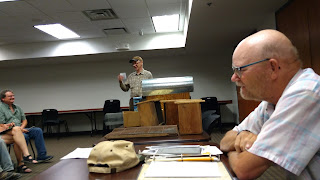President Dave Irvin called the meeting to order at 6:40. He welcomed and asked new attendees to identify themselves and tell a bit about themselves and where they are with beekeeping.
Floyd Otdoerfer:
Floyd began the meeting with a review of the annual meeting of the Iowa Honey Producers Association, held in Oskaloosa November 10 and 11. The meeting was well attended, with a number of vendors present.
Much discussion from various speakers focused on the varroa mite, its effects and control strategies. State apiarist Andy Joseph talked about the importance off making splits, which helps limit the number of mites per hive. He suggests doing splits about the 3rd week of April. Be sure to feed hives mid-March, as that is a prime time for hive starvation. Mites may begin slowly in the spring but 1 mite in April can become 150 mites in August, according to Pat Ennis and Adam Ebert, who spoke at the meeting. 1000 mites can doom a hive. Though mites are often seen in photos located on the upper thorax of the bee, they actually feed on the bees underside.
There was considerable discussion of mite control, with oxalic acid listed as a favorite treatment, since it does not significantly harm the bees, being a natural substance even found in honey. Most seemed to favor the dribble method, but local beekeepers such as Paul Gardner prefers the vapor method. Paul said he treats after Thanksgiving, with one of the benefits of using vapor is it can be applied in cold weather, and in fact is better applied when it is colder. It was mentioned that Randy Oliver has said that the duration of contact of the bees with the oxalic acid is an important factor in its efficacy.
Dennis VanEnglesdorp indicated that summer losses have now become as serious as winter losses. He says hives should be treated for varroa 3 to 4 times per year. He also suggests keeping colonies young. If you have a rob-out, take care of the hive right away so bees do not pick up and spread mites and diseases. Again, making splits and having young, vigorous queens can help keep a colony strong. Keeping hives spread out instead of sitting immediately next to each other can help minimize disease and pests.
Adam Ebert talked about queen rearing. He says grafting late afternoon is the prime time. If a queen cell becomes damaged, adding a small amount of beeswax can help save the cell. Adam says 25% of queens being developed do not survive. Middle May is a prime time for queen production. Adam likes to run about 25 hives at a site. Marian Ellis, from Nebraska, says that feeding bees before introducing a new queen can help with acceptance. Keep the queen in her cage for 4 days. Give the bees something to do to help distract so they are not focusing solely on the new queen, even so much as adding a bit of honey to the cage.
 |
Thanks to Patty Stewart for bringing in some tasty honey from Cuba and Italy to sample.
|
Winterization
Floyd began a discussion of winterization methods. Some members wrap, some do not. Protect hives from wind on the north and west sides. Moisture is a big concern. The use of quilt boxes, stuffed pillows or even, as Floyd uses, having pipes lead out from inside the hive can help with excessive moisture in the hive in the winter. Even placing bags of leaves around the hive can help insulate. It was mentioned that the Mountain Camp method of putting a pile of sugar on newspaper on top of the frames can absorb moisture.
Other Items
--Using ultraviolet light to treat frames from a deadout was discussed. Those interested may help participate in an informal study to see how effective the treatment is. Contact Will Swain for more information. will.swain072@gmail.com
--Paul Gardner will be selling packages April 16 and May 12. Contact Paul at 319-400-4228.
--Floyd said we will try to get a speaker for the March meeting. There will be others at the next meeting who also will be offering packages for sale.
--Tim Willbanks suggests having cotton balls or some kind of fluffy material on the hive floor can help trap mites.
--if you hold a frame up to the light and seee small crystals, it is not crystallized honey but mite defecation
--small hive beetles are now in our area. Minimizing the amount of space bees have to cover to control the beetles is important.
--In April, a joint study between the US Geological Surveyand the University of Iowa found traces of neonicotinoids in the Iowa River and even in local tap water.
--Sneeze weed (helenium annarum) , also known as bitterweed, can be found in roadside flower mixes. It can produce a bitter honey and should be avoided if possible.

Drawing
Thanks again to Floyd for providing items for a raffle to end the meeting.
Submitted by Jim Davis, Secretary
Please send any corrections or additions to davisjk@southslope.net






